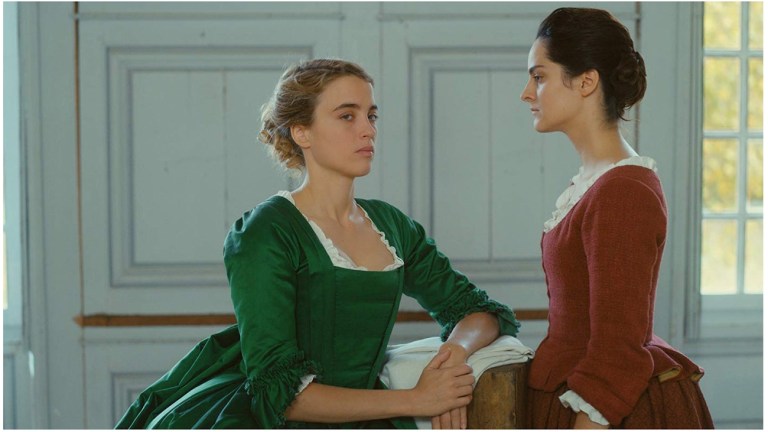Portrait of a Lady on Fire Review
Portrait of a Lady on Fire is like a moving painting. But it's even more transfixing when its characters' interior lives hold you still.

There is much talk about the standards and shackles of convention in Portrait of a Lady on Fire. This should not be a surprise since the exquisitely realized film from writer-director Céline Sciamma follows a young painter in the 18th century who is assigned the task of crafting a portrait literally intended for the male gaze. But just as this woman and her living subject debate the merit of aesthetic truth, and the fleeting quality of an individual’s essence, the film itself is a triumph in unconventional, honest moviemaking.
Constructing a slow boil romance between two women whose shared words barely rise above an innocuous simmer, Sciamma creates a vision as detailed as the best of 18th century artistry. The toast of Cannes and now the New York Film Festival, Portrait of a Lady on Fire asks the audience to study each hushed frame, and in the process reverses the suggestion that portraiture is at its most haunting when it looks like the eyes are moving. In the case of the stolen glances between Noémie Merlant and Adèle Haenel, it is the layered detail of their performances, and the way that they’re photographed, that makes it seem as if they’re not moving at all. This is cinema distilled to the minute, and characters whose visible inner lives can take on the immortalized quality of a mural’s subject.
Set near the end of the 1700s, Marianne (Merlant) is a woman traveling to the French coast as if she is a mercenary for hire. And in many ways she is. While her father is considered a great painter, Marianne is treated as a second choice talent by many due to her gender, including La Comtesse (Valeria Golino) who has retained Marianne to paint a portrait of her daughter Héloïse (Haenel). Marianne is the second person imported for the task, following an unfinished effort by a male contemporary. As it turns out, Héloïse refuses to sit for anyone who would mimic her likeness on a canvas, as it’s meant to lure an Italian nobleman into proposing marriage.
Hence Marianne is given the uncomfortable job of not only being the weaver of Héloïse’s marital bonds, but also to do so in secret. Héloïse is told that Marianne is meant to be a companion for long walks on a chilly shoreline—and while on these strolls, Marianne must in turn memorize every contour of Héloïse’s face and essence if she is to capture it in still life. But what Marianne could not conceive is how quietly she and Héloïse develop romantic attachments that are never fully articulated but eminently understood.
Ostensibly a period piece, Portrait of a Lady on Fire contains an immediacy as vivid as its title, surpassing any form of genre expectation. French actors Merlant and Haenel blend performances that are both mired in loneliness and an intangible longing for a life as full as the sweeping landscapes around them. Their portrayals are a mutual construct of naturalism that also distinguishes each characters’ very different ideas of individuality.
In Dorothée Guiraud’s costumes, they cut striking silhouettes on windswept cliffs above the ocean. But more impressive is the way that even at the height of their romance, there is something ghostly nostalgic about how they view one another. Especially Marianne, ever the artist and poet, appears haunted by Héloïse even when they’re left alone for a week. Frequently touched with visions of her subject in the wedding dress her painting is driving her toward, Marianne is already living this moment as the memento it’s destined to become. Sequences like this are designed in subtle and intimate shots by Sciamma that reveal a nuanced practicality in both women as opposed to melodrama one might anticipate from the material.
She and cinematographer Claire Mathon achieve an aching grace in all of their choices, which are allowed to breathe on the screen with almost no score at all. It is the emotion of the scenes that create a melody for the audience. As fine an example as any to date for the merits of a female gaze telling a female story, the sensuality and physicality of Sciamma and Mathon’s compositions are devoid of the lustiness such subject matter might conjure from directors like Abdellatif Kechiche. Rather the humanity of the women’s souls and the quietness of the way they take each other in (or miss the moment of the other’s glance) is what dominates. As does a refreshingly feminist narrative that—as it eventually ropes in maid Sophie (Luana Bajrami) as a third conspirator—still has profound implications to this day.
The significance of these moments is contextualized by how Marianne captures them via her own private sketches (each one a monument to a fleeting life event). By extension, Sciamma and Mathon’s own beautiful and meticulously designed photography is reinforced by the cinematic images’ two-dimensional echoes inside Marianne’s book. Portrait of a Lady on Fire drinks as deeply from its characters’ humanity as it does its painterly landscapes. Many frames of this film could be paused and mounted on a wall, just as Marianne chooses select moments to comprise her sketches. But taken together, their whole qualities really do burn with that eponymous fire.
